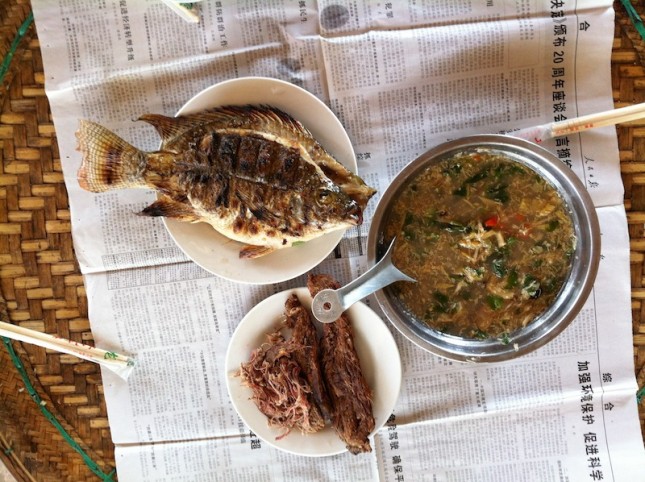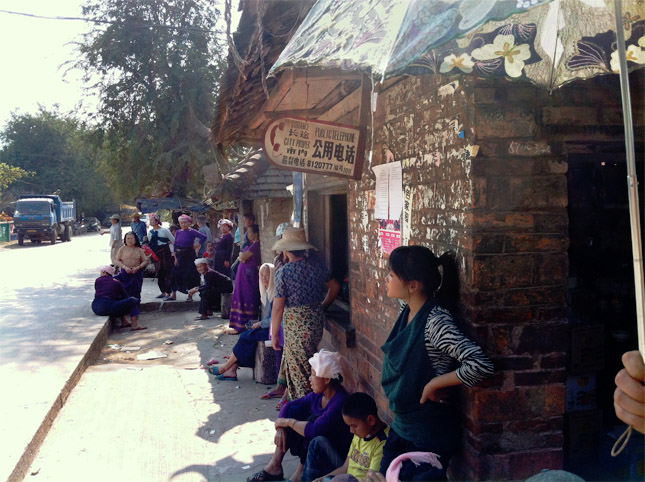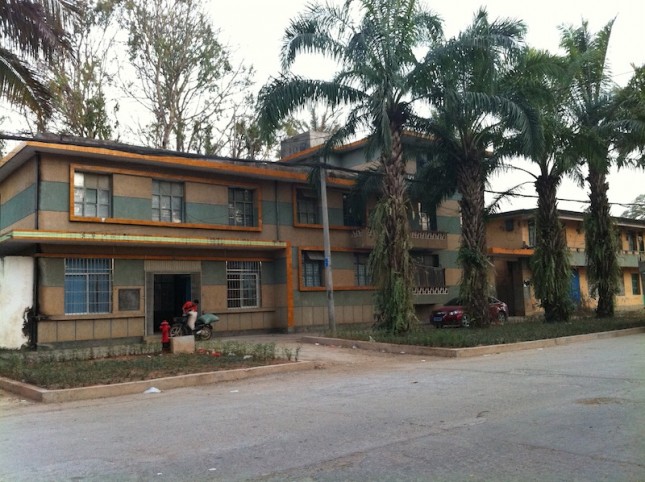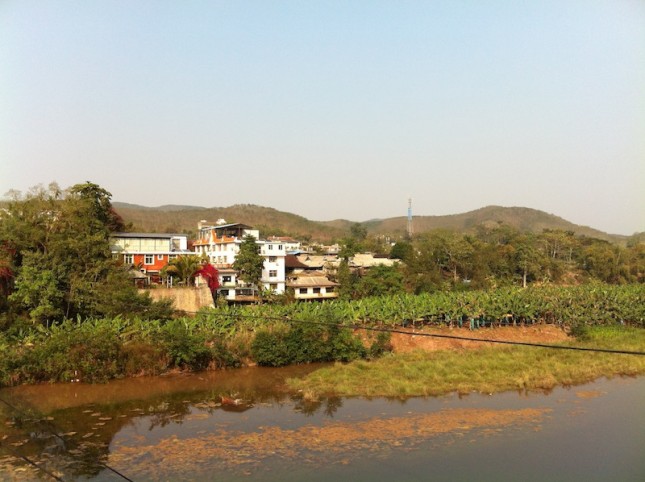Xishuangbanna—An Introduction
February 25th, 2012

I traveled to Xishuangbanna by bus, heading south through the Yunnan countryside for more than seven hours while bad movies like Baby’s Day Out and loud music videos intended for karaoke parlors played on the overhead screens. We drove past the farms that fan out along the side of Lake Dianchi, south of the city, all of them covered with arched plastic hothouses that made the plain look like the quarantine scene from E.T., then headed into the mountains, through the dry, parched landscape of winter in monsoon country. We wound our way through evergreen forests dotted with clumps of wild, wooly bamboo that shot out of the hills in huge tufts, each culm bending out, away from the others, like the long, tapering head of some shaggy muppet of a dinosaur. Farther south, the forests gave way to the low, terraced shrubs of tea plantations, the plants dormant for winter, partially shaded by the occasional banana tree or, toward the end of the drive, line of palm trees.
Xishuangbanna, Yunnan’s southern-most area—also known as the Dai Autonomous region—borders Laos and Burma and is a strange mix of Chinese and Southeast Asian cultures. Jinghong, the region’s capital, feels like a typical small Chinese city filled with shopping malls and traffic, but once you leave town, China recedes and you find a landscape filled with rubber, banana, and tea plantations and large swaths of tropical rainforest, all dotted with the rural villages of the Dai, Hani, Bulong, Yi, Lahu, Jinuo, Yao, Hmong, Hui, Wa, Zhuang, and Jingpo minorities that make their home here.

Grilled fish, dried beef, and banana flower soup
I’d come to Xishangbanna to learn to make some of the local foods from a cook named Mi Zhuang whose daughter, “Nana”, was a biology PhD candidate I’d met in Kunming. Nana had warned me that her mother didn’t speak any English, but she wrote down some directions for me, and after an hour-long bus ride from Jinghong and a ten-minute tuk-tuk ride, I found my way to Mi Zhuang’s restaurant, an open-air place next to a banana plantation outside the tiny rural town of Man’e.

Hanging out by the main road in Man’e
Man’e, a tiny town outside of the slightly larger town of Menglun, was a perfect combination of the region’s old traditions and the new, modern influences that are just beginning to be felt in the distant countryside. While most of the houses, propped up on stilts to create a cool storage area under the living quarters, are made out of wood, a handful of the village’s more prosperous residents have rebuilt in modern concrete and colorful tile, making their homes sturdier and more weather-proof while maintaining the traditional style. Inside Mi Zhuang’s modern concrete home, which she has painted a bright, minty green and roofed with dark blue corrugated metal, the computer that her granddaughter plays on (and which Nana presumably worked on throughout college and graduate school) provides an almost shocking contrast with the rustic, dimly lit kitchen situated under the eaves of the house a few yards away.
Mi Zhuang, however, usually cooks in a different kitchen, the bright, spacious space at her restaurant, Hong Dou Yuan Yu Zhuang, or “Red Bean Garden Fish Farmstead”, which is just down the road from the village. The food in Xishangbanna is all strongly influenced by the foodways of the Dai minority, a branch of the Tai people who migrated from China into Thailand and Laos and now make up the majority of those countries’ populations. Like their cousins to the south, the Dai are partial to sour and spicy dishes, make use of the tropical plants of the region, and often grill meats.

Local ingredients in the market in Jinghong
Mi Zhuang’s food reflects these regional preferences. She grills fish raised in ponds behind the restaurant, wraps ingredients in the leaves of the banana trees that grow outside her kitchen door, douses fresh vegetables in lime juice, flavors soups with the wood of a local plant that imparts a spicy, numbing flavor, and makes the area’s famous boluo fan, or pineapple rice. Over the course of two days she taught me to make a simple grilled fish filled with fresh herbs and chiles as well as simple grilled pork belly seasoned only with salt; fresh cucumber dressed in herbs, chiles, crushed peanuts, and lime juice; pineapple rice; fish filets grilled with herbs inside a packet of banana leaves that imbued everything with their delicate flavor; boiled bitter banana flowers with a spicy grilled tomato-based dipping sauce; fried river weed; battered, fried eggplant; and a dish of shredded celetus dressed like the local version of green papaya salad with herbs, salt, and lime juice. (Recipes to come in later posts.)

A lunch time feast
When not in Man’e, I also explored the food possibilities in Jinghong. In an enclave of Dai restaurants situated in a modern strip mall (built, of course, to look like a cluster of old wooden buildings and situated next to huge modern apartment complexes) I ate grilled pigeon, ground beef stir-fried with mint, and fresh cucumber sticks with a salsa-like dipping sauce, all accompanied by a big bowl of congee-style rice flavored with chunks of pork. And just next to the Jinghong airport, in the town of Gasa, I wandered through a traditional Dai village, walking through the empty streets at sunset while the locals bathed in communal pools, the woman, wearing their sarongs for modesty, chatting and washing their hair on one side while the men laughed and joked in another pool just around the corner.

Communist-era buildings in Gasa

In the Dai village
My last day in Xishuangbanna, I took the bus to Menglun to visit one of Xishuangbanna’s most renowned spots, the Xishuangbanna Tropical Botanical Garden. The garden, a 2,000 acre piece of land managed by the Chinese Academy of Sciences, is primarily a research facility for biologists from around the world (including many of our friends in Kunming), but the portion of it devoted to a display of the world’s tropical plants is also a beautiful park that draws tourists all year long.

Plants at the botanical garden
I arrived around lunchtime and found my way to the garden’s canteen. Though the spare, white space looked like every other government-run cafeteria I’ve been to in China, the food turned out to be delicious, and I took my time over a meal of stir-fried mustard greens and a soup filled with shredded banana flower and luscious, meltingly soft pieces of braised pork with flecks of parsley, all bathed in a broth flavored with young coconut milk.
The rest of the afternoon I wandered the park. I walked through the bamboo grove, which displays not only the usual clumping bamboos but also the many unusual varieties native to Yunnan like the Bambusa vulgaris “vittata”, an ornamental variety that boast bright yellow stalks with thin green stripes. I wandered through a citrus grove that was just beginning to flower, filling the air with a delicate perfume, admired the dozens of kinds of palm trees planted around the garden’s small water lily-filled pond, and marveled at the beautiful flowering trees and shrubs in the “Distinctive Plant Collection.” Finally, toward the end of the day, I walked out to the eastern side of the garden, away from the tourist areas, and found the area planted as a tropical rainforest. Under the vine-covered trees, shaded from the afternoon sun, I sat and listened to the soft sounds of birds chirping and leaves falling, enjoying the coolness of the damp forest air before starting the long, hot walk back to Menglun and the bus that would take me to Jinghong to get ready for the long trip home to Kunming.

A view of Menglun leaving the botanical gardens
Photos: Georgia Freedman



